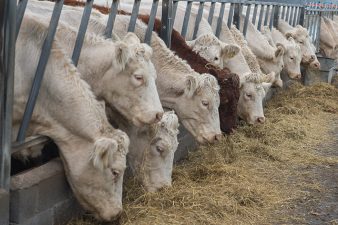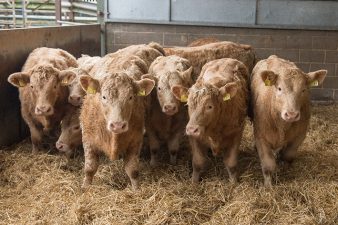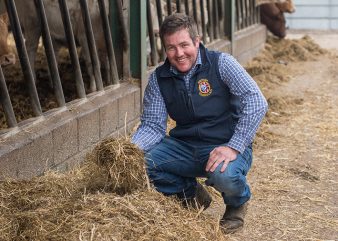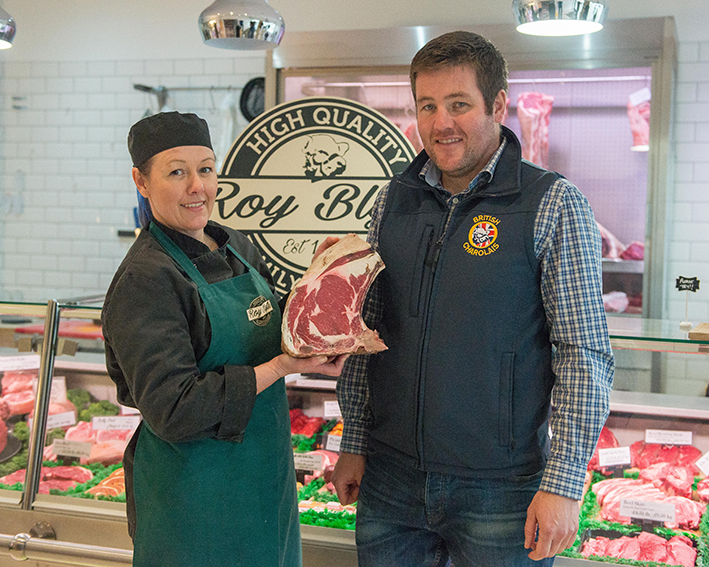With hard work, and a commitment to producing quality home grown meat, the Blyth family from Hartlepool has seen demand for their beef and lamb though their butcher’s shops grow year on year. We talk to them to find out the secret behind their success.
Neil Blyth, is part of a family enterprise that currently runs two successful butcher’s shops in Hartlepool as well as a 500-acre beef, sheep and arable enterprise at Middleton House Farm.
“There’s no secret to our success,” says Neil. “Dad started with his first shop in the 1980’s, and it’s been a lot of hard work to get where we are today. To succeed, we’ve needed to be aware of what our customers want, and we’ve changed our farming methods to meet these. Obviously, we’re in a position where we have an integrated business, and this gives us valuable insight into our end consumer as well as an opportunity to adapt to ensure market demand.
 “It’s been an important selling point, and a principle of our business, to produce the beef and lamb that we sell. That way we have the control over the product. We’ve built our business on supplying locally produced, home grown, quality meat.
“It’s been an important selling point, and a principle of our business, to produce the beef and lamb that we sell. That way we have the control over the product. We’ve built our business on supplying locally produced, home grown, quality meat.
“We’ve tried different breeds over the years in order to get the most out of a carcase – and supply quality meat to our shops. We need to ensure we have good cover on the carcase to enable us to hang it for up to 28 days. Our aim, as a butchery business, is to use as much of the carcase as possible, from the inexpensive cuts to the high-end sirloin steaks, so quality throughout is vital if we want to meet the needs of all our customers.”
The farm currently produces three to four beef animals a week for their shops and, with changing tastes, Neil has found the modern Charolais to be the best suited for his marketplace.
“The carcase we’re currently producing for our trade is smaller than many years ago, but it makes up for this with its efficiency. These animals are very cost effective from both a farm business perspective, and from shop sales.”
 Neil’s cattle are reared on a suckler system, which he believes produces the best meat for the market. “It’s such a natural system, and we strive to produce all the feed on our farm so we’re self-sufficient. This year, we’ve grown about 150 acres of crops – oats, barley, wheat and beans to get some home-grown protein. We’ve also rotated with rye and brassicas to ensure a range of alternative forages extending our grazing season. We feed a TMR throughout the winter months to ensure good growth, and work with a nutritionist to ensure a balanced and nutritious ration.
Neil’s cattle are reared on a suckler system, which he believes produces the best meat for the market. “It’s such a natural system, and we strive to produce all the feed on our farm so we’re self-sufficient. This year, we’ve grown about 150 acres of crops – oats, barley, wheat and beans to get some home-grown protein. We’ve also rotated with rye and brassicas to ensure a range of alternative forages extending our grazing season. We feed a TMR throughout the winter months to ensure good growth, and work with a nutritionist to ensure a balanced and nutritious ration.
“We calve 80% of our herd in the spring to utilise grazed grass, and give the cows and calves an environment in which they thrive. The 350-head herd is made up of Charolais, Saler and Simmental crosses, which are put to our homebred Charolais bulls.” Neil AI’s all the heifers, and calves them down at two years old.
“We keep all the resultant calves, and regularly weigh the animals to assess gains and conformation. What’s important, for our business specifically, is ensuring consistency, and we get this with the Charolais.
“We aim to finish the heifers at 320-380kg deadweight, and the steers at 350-400kg deadweight. The impressive thing about these Charolais crosses is their ability to convert feed to growth and the ability to produce a high yielding -quality carcase for the market. Having sufficient cover has become even more crucial for our business, as we’ve recently invested in a dry aging cabinet, where the fat cover is vital to encase the meat for a minimum of 28 days. Without it, the meat would lose its succulence and our sales would suffer.
 “From experience I believe the Charolais is suited to many systems, and the modern breed offers farmers an opportunity to produce cost-effective beef for the current marketplace. As a farmer, you want to rear high quality, healthy animals that grow well and sell well – the Charolais does this.
“From experience I believe the Charolais is suited to many systems, and the modern breed offers farmers an opportunity to produce cost-effective beef for the current marketplace. As a farmer, you want to rear high quality, healthy animals that grow well and sell well – the Charolais does this.
“Looking ahead I’d like to see suckler beef branded in the UK as I feel this offers greater marketing opportunities, and potentially a price premium. The retail trade should recognise different rearing systems, and price accordingly. Suckler beef is reared predominately on a non-intensive grass-based system, and I believe this is what the consumer wants. I think we could see a change in payments – with bonuses for marbling scores, as well as for grades.
“I’m very confident about the future demand for quality UK-produced red meat – we can produce it so efficiently in the UK and to a world class quality,” he concludes. “I believe consumers are becoming more and more aware of the food they eat, and how it’s produced, and that this offers great opportunities for the future.”
Categories: Commercial, News
Charolais continue the upward trend at Dungannon » « Improvement in herds genetics across the UK are recognised by the Harman awards
